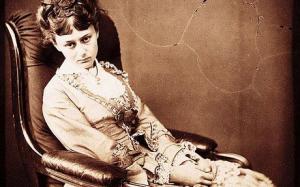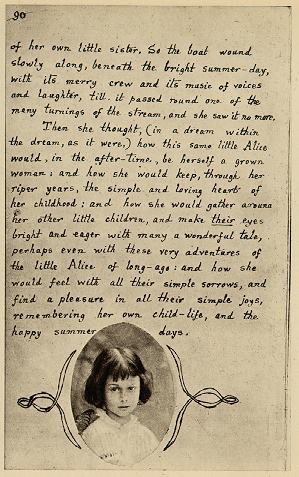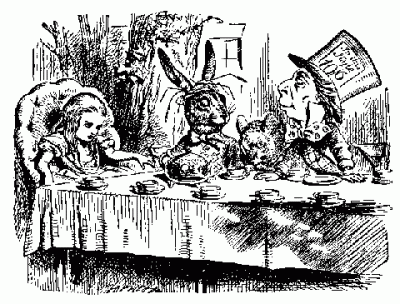The Virtual Victorian: The Real Alice In Wonderland
THE REAL ALICE IN WONDERLAND …
In 1864, Charles Lutwidge Dodgson – a young clergyman and mathematics don at Oxford university who was soon to become more widely known as the author Lewis Carroll – presented a charming little girl with the Christmas gift of a 15,000 word, handwritten manuscript.
Lovingly adorned with his own illustrations,
Alice’s Adventures Underground had been conceived on a summer’s day back in 1862 when Carroll had gone on a boating trip with Edith, Lorina and Alice – three daughters of Henry George Liddell, the dean of
Christ Church college.
The Liddell sisters, with Alice on the right. Photograph by Lewis Carroll

Alice was definitely Carroll’s favourite and the star of his fanciful stories. He first met her in the deanery gardens in April 1856. The day was marked out in his diary as one of great significance. Carroll was 24 years old – twenty years older than Alice.Though in later years he was to claim that the character of Alice was based on no actual child, in
Alice’s Adventures in Wonderland there are many references to Alice Liddell. For instance, her birthday was on May 4th and during the Hatter’s tea party we read –
‘The Hatter was the first to break the silence. “What day of the month is it?” he said, turning to Alice: he had taken his watch out of his pocket and was looking at it uneasily…Alice considered a little, and then said, “The Fourth”.’
The epilogue for
Through the Looking Glass is in the form of a poem, in which the first letter of each line spells out Alice’s full name of Alice Pleasance Liddell –
A boat beneath a sunny sky
Lingering onward dreamily
In an evening of July —Children three that nestle near,
Eager eye and willing ear
Pleased a simple tale to hear —
Long has paled that sunny sky:
Echoes fade and memories die:
Autumn frosts have slain July.
Still she haunts me, phantomwise
Alice moving under skies
Never seen by waking eyes.
Children yet, the tale to hear,
Eager eye and willing ear,
Lovingly shall nestle near.
In a Wonderland they lie,
Dreaming as the days go by,
Dreaming as the summers die:
Ever drifting down the stream —
Lingering in the golden gleam —
Life what is it but a dream?
‘Still she haunts me’ – Carroll’s poem possesses a dreamlike yearning and is filled with poignant memories of that balmy summer’s day when he rowed along the river with Alice and her sisters. And, whatever the truth of the matter, whether Carroll harboured a sexual desire or simply an intense affection for Alice and other prepubescent girls, he certainly recorded his interest in a vast collection of photographs – many of which the artist destroyed before his death. Some surviving images can be viewed at the
National Media Museum in Bradford, though you have to telephone to make a prior appointment.
Lorina and Alice Liddell, posing as Orientals
He also destroyed a page from his diary in 1863, after which his close relationship with the Liddell family was to come to an abrupt end. In later years other members of Carroll’s family explained that the page referred to Mrs Liddell being unhappy at Carroll courting the children’s governess. It is thought by some that the
Red Queen in
Through the Looking Glass was based on this Miss Pricket, described by Carroll in the following way –
“The Red Queen I pictured as a Fury, but of another type; her passion must be cold and calm; she must be formal and strict, yet not unkindly; pedantic to the tenth degreee, the concentrated essence of all governesses!” So, she was firm and not unkindly, yet would such a mature woman really be attractive to the same man who meets the twelve year old Alice and writes of his disappointment to see how she has grown: “
changed a great deal and hardly for the better.”



Alice grew up to be a beautiful and assured young woman. She was courted by Prince Leopold, Queen Victoria’s youngest son, who she met while he studied at Oxford. But, Victoria was adamant that her son should only wed a princess and Alice went on to marry another Oxford student by the name of Reginald Hargreaves. However, it can be no coincidence that Leopold named his first daughter Alice, and the prince was godfather to Alice’s son who was christened as Leopold.
Prince Leopold and his wife, doting on their daughter, Alice.
Despite the loss of her first love, Alice went on to become a successful society wife. It was only after her husband’s death when she found herself to be in need that she finally resorted to selling her original copy of
Alice’s Adventures Underground. In 1928, it was auctioned at Sotheby’s, achieving £15,400 which was four times the reserve price. In 1948, it changed hands again, that time bought by a group of American businessmen who, in turn, presented it to the British Museum.
In 1932, to mark the centenary of Lewis Carroll’s birth, Alice visited New York to receive an honorary doctorate from Columbia University. The trip was exciting but exhausting. It led to a deluge of letters and interest from the media, and her death in 1934 was marked by an obituary in The Times. Her ashes were interred in the family tomb in Lyndhust, Hampshire which is engraved with the following words : The grave of Mrs Reginald Hargreaves, the Alice in Lewis Carroll’s Alice in Wonderland.

The poignant last page of Alice’s Adventures Underground
Dreamchild (1985) is a film scripted by Dennis Potter with Carroll’s imaginary characters realised by the puppeteer, Jim Henson. It tells the story of Alice’s journey to a Depression era New York with flashbacks to her privileged Victorian youth with Carroll, who is played by Ian Holm. The part of the older Alice is taken by Coral Browne, who went on to recieve a London Evening Standard Film Award for Best Actress. Sadly, I can only find it available in VHS tape format in the UK, but it is available in DVD format from
Amazon in the US.
Tags: 17th Century 18th Century 19th Century England, Alice, Alice Liddell, Alice's Adventures in Wonderland, Carroll, children, Education, Hatter, Lewis Carroll, literature, National Media Museum, Oxford, world literature
 Alice was definitely Carroll’s favourite and the star of his fanciful stories. He first met her in the deanery gardens in April 1856. The day was marked out in his diary as one of great significance. Carroll was 24 years old – twenty years older than Alice.Though in later years he was to claim that the character of Alice was based on no actual child, in Alice’s Adventures in Wonderland there are many references to Alice Liddell. For instance, her birthday was on May 4th and during the Hatter’s tea party we read –
Alice was definitely Carroll’s favourite and the star of his fanciful stories. He first met her in the deanery gardens in April 1856. The day was marked out in his diary as one of great significance. Carroll was 24 years old – twenty years older than Alice.Though in later years he was to claim that the character of Alice was based on no actual child, in Alice’s Adventures in Wonderland there are many references to Alice Liddell. For instance, her birthday was on May 4th and during the Hatter’s tea party we read –











